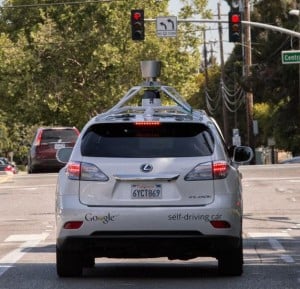 Drivers are not perfect, even the self-driving cars zipping around California. State law requires that all accidents in licensed self-driving cars must get be reported to the California Department of Motor Vehicles. There have been four reported accidents to the California DMV and today Google acknowledged a few more, all of the incidents without injury and caused by humans.
Drivers are not perfect, even the self-driving cars zipping around California. State law requires that all accidents in licensed self-driving cars must get be reported to the California Department of Motor Vehicles. There have been four reported accidents to the California DMV and today Google acknowledged a few more, all of the incidents without injury and caused by humans.
The Associated Press uncovered four accidents in self-driving cars three Lexus models with Google technology and one Dephi self-driving Audi out of the fifty self-driving cars in California. According to AP, two out of four were in self-driving mode when accidents occurred. All accidents occurred when the cars were moving at less than than 10 mph.
Delphi reported an accident occurred in October when its Audi SUV was stopped at a light when another car crossed the median and hit it. The Delphi vehicle was in manual driving mode at the time. A police report indicated the other vehicle driver was at fault. No one was hurt in the incident.
“Not once was the self-driving car the cause of the accident,” wrote Google’s Self-Driving car Director, Chris Urmson on story-telling website, Medium.
Urmson reported its self-driving cars were in 11 minor traffic accidents in the six years it has been testing them. Google reported its cars avoided many major accidents in over 1.7 million miles traveled. Google self-driving cars are averaging around 10,000 self-driven miles a week
Google cars have been rear-ended seven times, mainly at traffic lights but also on the freeway. Google cars been side-swiped a couple of times and hit by a car rolling through a stop sign. Google cars experienced more accidents per mile driven on city streets than on freeways; being hit 8 times in many fewer miles of city driving.
It’s interesting to note that is that when people encounter self-driving cars they say the autonomous are too cautious and almost frustrating. In fact, Urmson mentioned in his article that the self-driving cars wait before going forward a at stop light. This could lead to making the human drivers more frustrated and making assumptions about the Google cars the people crash into. The people driving around the Google cars may need to be educated to learn that they drive like my Grandma Lou who gripped the wheel very firmly and also was slow to move when the light changed because she needed to take an extra puff on her cigarette, first.
Urmson also did not report how many of the human drivers were looking at Google maps, sending notifications to Waze or looking for Google Places when they rammed into the Google self-driving cars.
The national rate for reported “property-damage-only crashes” is about 0.3 per 100,000 miles driven, according to the National Highway Traffic Safety Administration.
Google’s 11 accidents over 1.7 million miles equates to 0.6 per 100,000 miles. However, Google says as many as 5 million minor accidents are not reported to authorities each year. California has been ranked as the most dangerous state for road users with the majority of crashes in urban areas.
Delphi outfitted the first car to self-drive across the United States. Daimler, recently unveiled a auto-piloted big rig tractor trailer truck.
A Boston Consulting Group study found that for those who wouldn’t buy an an autonomous vehicle, the biggest considerations appear to be reliability, cyber security, and uncertainty about AV interactions with other vehicles on the road. Google filed a patent for self driving cars that when a car stuck, waiting for cows, the car will call for help from a human and or more advanced computer wireless through the cloud.